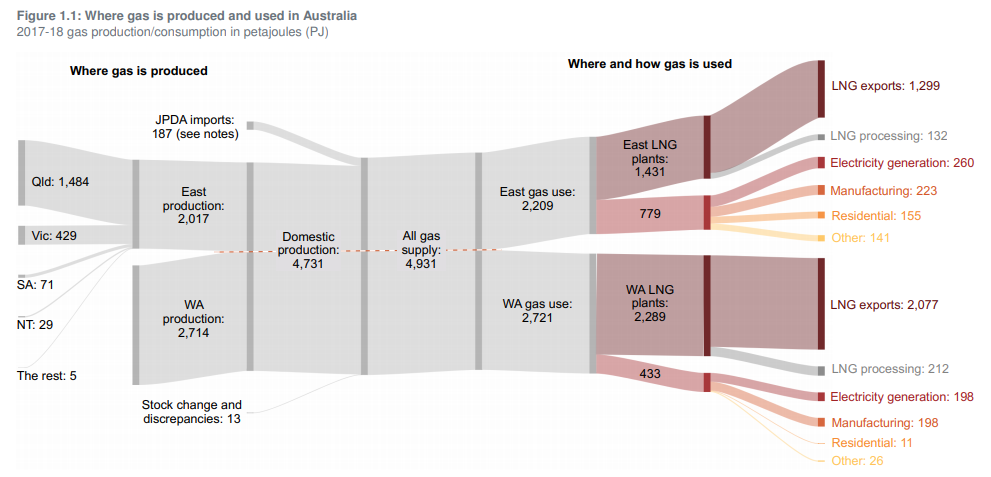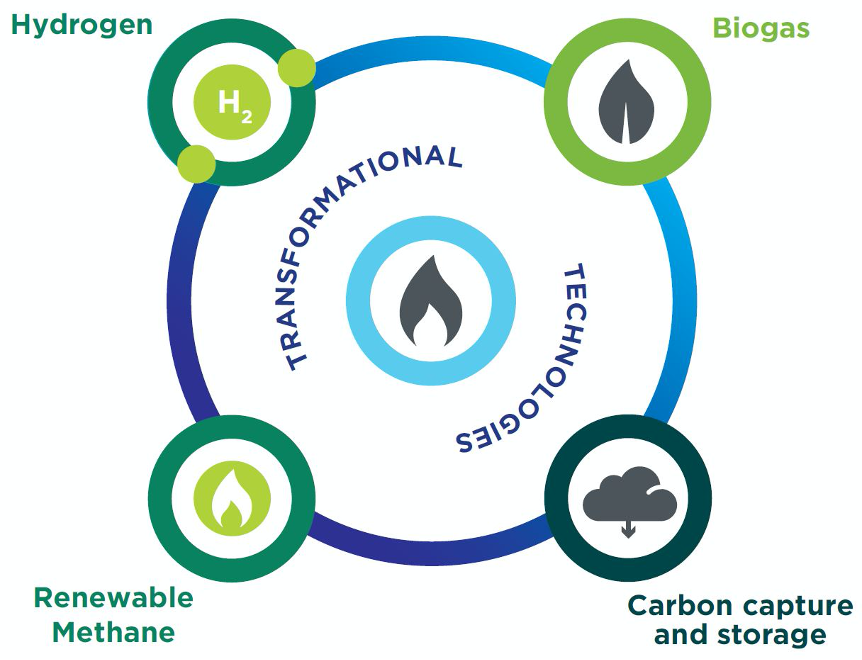Is Grattan opening a can of worms?
Gas across the supply chain
Gas plays a role in all states and territories in Australia. This is illustrated by a Sankey diagram matching natural gas sources with end-uses. Generally, this data is reported for either the east coast or for WA and the consolidated picture is a good representation of the extent of the gas market.
Figure 1: Sankey diagram of natural gas in Australia
Flame out?
Many of the Grattan Institute’s arguments are well-informed and credible, although at times they underplay the importance of natural gas across the economy. Overall networks, business and governments agree that emissions from natural gas need to reduce. Through Gas Vision 2050 Energy Networks Australia (ENA) and industry partners showing how industry is leading the demonstration of technologies to be able to achieve these reductions. However, Gas Vision 2050 offers a different pathway to achieving those emission reductions than that of the Grattan Institute.
Figure 2: Gas Vision 2050 Transformational Technologies
Gas in the homes
Customers have a strong connection with gas. Combined, nearly 70 per cent of Australian households use gas[i] for everyday services such as cooking, heating and hot water. A recommendation by Grattan to introduce a moratorium on new gas connections in new housing developments is in stark contrast to maintaining consumer choice and certain to draw attention.
We review Grattan’s six policy conclusions for gas in homes and suggest alternate options that can reach the same emission objective but retain customer choice, fuel diversity and lower costs overall.
Conclusion 1: Gather more information about best long-run approach
Grattan’s view: The costs of biomethane, hydrogen, and electricity will become clearer over time. But this process can be accelerated through focused policy analysis and research. Given the long-term uncertainty over the best approach, policy makers should start work to better understand the merits and limitations of each of these options.
ENA view: Agree, a full range of transformational technologies will be used to decarbonise the gas sector including biomethane, hydrogen, renewable methane and carbon capture and storage. Electrification may in some cases provide opportunities to replace fossil gas but a full range of options needs to be pursued.
Conclusion 2: A moratorium on new household gas connections is a ‘no regrets’ measure
Grattan’s view: New all-electric homes in NSW, Queensland, SA, and the ACT will save money compared to moving into an equivalent house with gas. And within the next five years these all-electric houses will also produce fewer emissions than houses with gas – even earlier for houses with rooftop solar. Grattan argues governments in these jurisdictions should put a moratorium on new household gas connections. This would be a ‘no-regrets’ measure – households would both save money and reduce emissions over the next decade.
ENA View: Disagree. The cost and emission savings from all-electric homes compared to dual fuel homes are highly questionable and dependent on how the appliances are used, the energy efficiency of the home and the energy usage patterns of its residents. Gas is a low emissions options today and will be zero emissions in the near future. As gas in gas networks becomes blended with biomethane and/or hydrogen, the associated emissions of gas use will decline. Increasing this blend to 100 per cent will provide both a gas and electricity network with no emissions across either ensuring more options and choices for customers.
Conclusion 3: Favouring electricity over gas is not ‘picking winners’
Grattan’s view: A gas connection moratorium is neither a case of picking a winner – electricity – nor a loser – gas. There are well established public policy rationales for a moratorium – one being the unpriced benefit of reducing emissions.
ENA View: Disagree. If emissions reductions were the required outcome, then that should form the basis for policy proposals. As it is, using gas in the home provides energy at lower greenhouse gas emissions than using electricity, especially in places like Victoria and New South Wales which are still predominantly coal-fired states. There are other options for reducing emissions that are being ignored by ‘picking winners’, such as improved energy efficiency of homes, carbon offsets, biomethane blending and hydrogen blending. Customers should be informed about these options and empowered to make them, rather than restricting consumer choice through a moratorium.
Conclusion 4: The effect of a moratorium on consumer choice can be reduced
Grattan’s view: A moratorium explicitly reduces choice. It works against the preference of many people to cook with gas. Governments could preserve an element of choice, particularly for cooking, by ensuring that moratoria only cover mains gas connections, but not bottled gas.
ENA view: Agree and Disagree. ENA agrees that a moratorium reduces choice and hence is not in customers’ interest. Furthermore, Grattan justifies the moratorium for reducing emissions but then identifies that LPG should be exempt from the moratorium so customers can continue to use gas. But LPG has greater inconvenience, greater cost[ii] and increased emissions[iii] compared to gas supplied by networks. This policy conclusion makes no sense.
Conclusion 5: Low-emissions gas supply should still be allowed
Grattan’s view: Dedicated networks that can supply only low-emissions gas should be exempt from the gas connection moratorium.
ENA view: Agree. Blending of renewable gas will commence in November 2020 in Adelaide. This will be followed by other blending projects as well as demonstrating the conversion of entire networks to 100 per cent renewable gas in the next few years. New residential developments may be good candidates for blending projects and 100 per cent renewable gas trials as these projects could be built around a range of hydrogen appliances and/or a dedicated renewable gas facility. The new networks could be isolated from the existing network until such a time that 100 per cent renewable gas is flowing across the whole network.
Conclusion 6: Consider how to manage transitional issues
Grattan’s view: Transitioning from natural gas to alternative fuels may be difficult, but we cannot avoid the challenges by ignoring them. Transitional issues are not just about economic efficiency, but also about fairness and consumer acceptance.
ENA view: Agree. Consumer choices are under attack through a recommendation of a moratorium. Gas networks are fully supportive of the need to decarbonise natural gas and through Gas Vision 2050 are demonstrating how industry is addressing that challenge. In working to reaching net zero industry and governments also needs to consider the system’s issues. Gas provides more than twice as much energy than electricity and the analysis in Gas Vision 2050 shows it would cost twice as much to electrify this energy compared to decarbonising the gas using hydrogen.
Supportive policy for reducing emissions includes gas
There is strong support to reduce greenhouse gas emissions. Reducing emissions from gas via energy efficiency of homes and decarbonising the fuel is preferred to electrification as it provides consumers with choices, reduces the need for governments to incentives electrical appliances and avoids unnecessary investments in infrastructure.
Grattan did not take a customer perspective in their latest report, but instead adopted an autocratic position. Customers are willing to pay for clean gas but the current policy frameworks do not exist. Proposals to develop and implement renewable gas targets, certificates and markets would enable faster reductions of emissions compared to misplaced incentives for heat pumps and moratoriums on gas network expansions. That would be a better option to get to “flame green.”
[i] This includes both gas supplied via network and that supplied via the ‘virtual’ pipeline – LPG.
[ii] Natural gas delivered via pipeline is roughly half the cost of LPG – although this varies a lot depending on global oil prices
[iii] LPG has a higher emission factor of 60.2 kg CO2/ GJ compared with natural gas’ factor of 51.4 kg CO2/GJ




